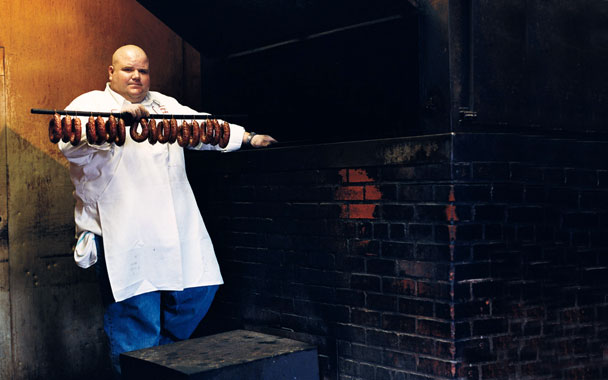Texas is brisket territory, but it is no lone-meat state. Pit-cooked sausage is also required eating, especially in the barbecue shrines south and east of Austin. Peppered, coarse-ground beef is packed into pork gut that is porous enough to suck in flavor from woodsmoke as it cooks but impermeable enough that no juices leak out. Larger cuts like brisket, ribs, and mutton can laze for hours on the grate, where the flue at one end of the pit draws smoke from fire at the other, maintaining a temperature of about 250 degrees. But the more diminutive link and ring sausages swell up fast. When they are done, the casing has been transformed from translucent membrane into chewy, wrinkled coat, but its contents remain moist.
The Southside Market knows a thing or two about this process. It has been Elgin’s butcher shop since 1882. Although it moved from downtown to modern quarters on the highway 16 years ago, it remains one of a handful of regional pits that feature sausage cooked, served, and eaten primitively, with no adornment at all. Step inside and the sweet smell of beef steeping in the smolder of oak wood thickens the air as it surely did when Texas barbecue began more than a century ago as the meat markets’ way of making use of unsold and unwanted cuts.
A Southside Market link weighs about a quarter pound and is six inches long, its orange skin dotted with pepper flecks. As the counterman assembles the food—which can be ordered by weight or plate—he cuts each one not quite all the way through in four places so it holds together but can easily be pulled into segments. Sauce is available, and it has a beguiling tang that perks up brisket, but the link is so overwhelmingly juicy that you would never think of saucing it. Its robust flavor—peppery enough to leave an afterglow but not so hot that it numbs your tongue—wants no condiment whatever. Elgin sausage is so authoritative, however, that alone on a plate it just might be too much of a good thing. It does, however, make a perfect foil for Southside Market’s excellent brisket, mutton, or ribs. Elginites start eating hot sausage and brisket every day at 8 A.M. Preferred side dishes are raw onion slices, pickles, and sometimes a hunk of orange cheese.
Louie Mueller, a magnet for devotees of smoke-cooking, may be the most beloved barbecue parlor in the state. Housed in a big hall that was once a school gymnasium, its peeling-paint walls have been exposed to smoke for so long that they have become the color of tobacco; its ambience is churchlike, so dark it appears to be lit by candles. “I’ve got one sausage left,” says assistant pit boss Lance Kirkpatrick when we arrive for lunch at 1 P.M.
“We’ll take it!” we exclaim, feeling mighty lucky. The last link from the pit, which Kirkpatrick delivers by hand directly to the sheet of butcher paper that lines our tray, sports a leathery, crackle-textured skin and glows with salt-and-pepper zest. Some juice spills out when it is bitten, but it isn’t nearly as plump and oozy as a traditional Texas hot link. “You got the short end of the stick,” Kirkpatrick jokes. “I’ve been worrying that link all day. But I’ll tell you what. We have people who come in and ask for it just like that. You know, ‘one of those nasty old ones from the corner of the pit.’ ” Sublime as the juicy links are, there is something to be said for these well-done sausages, known to pit men as dry links because so much fat has been rendered out of them. Extra time on the grate diminishes the wanton hedonism of the sausage and concentrates its flavor into an edible epigram of beef, pepper, and smoke.
Even when the long communal tables at Luling’s City Market are crowded and a dozen conversations are in full swing all around, you can still hear the crunch and snap as diners’ teeth bite into the unbelievably taut casings of all-beef sausage rings. Horseshoe-shaped and string-tied, they have a lean, rugged grind with only the echo of pepper laced through their mineral-rich muscularity. As is true of all the great sausage shrines of central Texas, you fetch your own meal at City Market, venturing into an enclosed back room, where the smoke haze is dense and the temperature is about that of Hades, and telling one of the pit men how many sausage rings you want and how much brisket he should slice to accompany them. He arranges the selection on a couple of sheets of pink butcher paper along with slices of the soft white bread that is ubiquitous in the area’s smoke parlors. Pegging us as out of towners but not wanting to embarrass us among the crowd of locals getting lunch, our man tactfully demonstrates how to keep the butcher paper wrapped around the meal as we prepare to carry it to a table. Big men exit the pit room carrying their pounds of meat swaddled in paper with the extreme care they might give a newborn baby. There are no plates at City Market, and if you want a utensil there are plastic knives in a cigar box near the cash register. Few people bother. Messy as it is, Texas barbecue is finger food. It is a meal to feel as well as to taste.



 Pinterest
Pinterest






